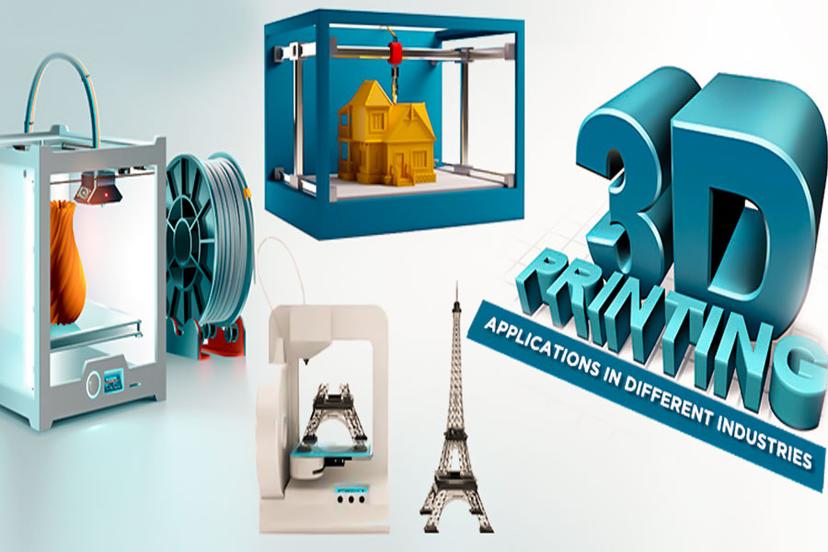With the rapid development of science and technology, 3D printing technology, as a revolutionary manufacturing method, is revolutionizing the manufacturing industry worldwide. From initial prototype production to today's diversified applications, 3D printing technology has shown great potential and value in many fields with its unique advantages. This article will delve into the wide range ofapplications of 3D printingtechnology and reveal its unique charm and far-reaching impact in different industries.
What is 3D Printing?
Its additive manufacturing expertise creates exact and complex practical parts or merchandise by stacking and fusing successive layers of fabric. So, a 3D printer doesn’t use a fabric block to govern the form. As a substitute, the nozzle deposits materials layer by layer from the underside up within the print mattress based on the slice sample of the uploaded design.
In the meantime, slice sample refers back to the person’s horizontal layers into which a CAD mannequin is split. Every slice represents a cross-sectional space of the dummy that the printer follows to deposit the fabric layer.
How does 3D printing work?
1.Digital modeling
First, a digital 3d models printing needs to be created using computer-aided design (CAD) software or other 3D modeling software. These software enable users to design complex geometric shapes and create structures. After completion, users can export the3d printing modelsto 3D file formats such as STL and OBJ to facilitate subsequent processing in 3D printing software.
2.Data processing
Import the 3d printing model file into the 3D printing software, and the software will generate a series of slice information based on the model data. This slice information describes the shape and position of each layer in detail, providing guidance for the subsequent printing process. According to specific printing needs, users need to adjust printing parameters, such as layer height, printing speed, material temperature, etc., to ensure that the printed items meet the design requirements.
3.Printing process
Place the selected printing material (such as plastic, metal, ceramic, etc.) into the 3D printer. These materials are usually in powder, liquid or filament form and can be pre- or cured as desired. The 3D printer will heat, ink jet printing or extrude the material layer by layer based on the slice information, and display them together accurately. The process is similar to manual machining in traditional manufacturing, but 3D printing enables more complex structures and shapes. During the printing process, the3D printer will control the temperature of the materialaccording to default parameters to ensure printing quality and stability.
4.Post-processing
For some complex structures that require support,3D printers will add additional brackets during the printing process. After printing, these brackets need to be removed. Since there may be some imperfections during the printing process, such as rough surfaces, gaps between layers, etc., the printed objects need to be trimmed and polished to improve their appearance and performance.

What Are the Applications of 3D Printing?
- Manufacturing:3D printing is often used for rapid prototyping, which can quickly produce physical models to help engineers and designers verify design concepts. It can also be used to produce complex parts, reducing material waste and process steps.
- Medical industry:3D printing applications in medicineinclude customized prostheses, dental restorations, surgical guides, and bioprinted tissues. This technology allows for personalized medical devices to be tailored to the specific needs of the patient.
- Aerospace industry:Because3D printing can produce lightweight and structurally complex parts, it is used in the aerospaceindustry to manufacture parts for aircraft and spacecraft, significantly improving fuel efficiency and performance.
- Construction industry:The construction field uses 3D printing to produce architectural models, and is exploring the possibility of using 3D printing to directly build houses. This method can shorten construction time and reduce labor costs.
- Art and Fashion: Artists and designers use 3D printing to create intricate sculptures, fashion accessories and clothing, pushing the boundaries of traditional art creation.
- Education industry:In education, 3D printing is used in laboratory teaching and course demonstrations to enable students to physically understand complex concepts and theories.
- Food industry:3D food printers can print chocolates, candies and other foods, achieving complex design and rapid production through precise control.
- Automotive industry:Theautomotive industry uses 3D printing technology to produce prototype vehicle parts,tools, and gradually for end-part production, thereby increasing development speed and simplifying the supply chain.

What are the advantages of 3D printing?
3D printing manufacturing is advantageous for several purposes. It gives design flexibility, sooner lead instances, customization, and many others. Right here is the elaboration of typical 3D printing benefits;
1.Design Flexibility and Complexity
If we compare the design's attainable intricacies with compression molding and 3D Printing, we can see that a 3D printer creates extremely advanced geometries and contours. It additionally provides more complexity than standard strategies like CNC lathe machining or injection molding. It doesn’t limit intricate hole sections, undercuts, and inner lattices as subtractive manufacturing does.
Moreover, the functionality of advanced shapes directly benefits designers. They’ll make more progressive and complex designs to resolve manufacturing needs. Furthermore, designers shouldn’t have to consider draft angles, software entry, thickness uniformity, massive meetings, and different restrictions when making3D printing designs.So, it leads to final design flexibility.
2.Fast Prototyping
Manufacturing velocity, good precision, and cost-effectiveness make3D Printing a dependable possibility for fast prototyping tasks.Depending on the complexity and 3D-printed supplies, an element could take a few minutes to several hours. Moreover, prices are lower with 3D printing prototyping due to zero upfront tooling cost and a straightforward design-changing process.
For instance, you can rapidly prototype and evaluate a brand-new drone design with vital changes on the fly by 3D printing iterations. At the same time, with different strategies, it’d take as much as months.
3.Customization and Personalization
The 3D printing processes are directly manufactured from digital information to deal with advanced designs. Consequently, 3D printing permits for {custom} parts and merchandise based on particular wants. When you’ve got a {custom} design (3D Mannequin), you can precise it into bodily actuality with appropriate supplies and printing gear.
This customization is extensively helpful for medical purposes. For instance, 3D Printing can manufacture custom-fit-implants for sufferers.
4.Value-Effectiveness for Small-Batch Manufacturing
The principal reason for the low price of 3D-printed parts in small-batch manufacturing is that they don’t require costly manufacturing setups like molds or tooling. In the meantime, different approaches like injection molding require heavy upfront investments in molds, which result in more significant per-part solids for small batches or low-volume manufacturing.
For instance, small-batch manufacturing for Nylon parts first calls for an aluminum injection mildew that costs a minimum of $10 0 00, whereas there is no such price for 3D Printing.
What are the disadvantages of 3D printing?
Though3D Printing has many advantages, it has some limitations, such as material alternatives, measurement, precision, and floor end. Let’s discuss each downside individually.
1.Materials Limitations
The fabric alternative is smaller for 3D Printing than for different processes like CNC machining. There are even fewer choices in 3D Printing vs. compression molding. The 3D printing machines are sometimes suitable with plastics (ABS, PETG, and TPU), photopolymers, a few thermoset supplies, and metals (metal, titanium, and aluminum).
Nonetheless, 3D Printing has quickly expanded its materials capabilities beyond fundamental thermoplastics. More supplies have become suitable because of material science improvements and new 3D Printing applied sciences.
2.Decrease Power and Sturdiness
As 3D printers convert the design by including materials layers, the final half compromises the mechanical energy. For example, FDM parts delaminate or underperform underneath stresses on the Z-axis’s specific orientations (Z-rally). Moreover, parts could lose their authentic properties, such as hardness or fatigue energy. For these reasons, the parts additionally become much less sturdy.
3.Floor End and Precision
The parts from 3D Printing depart from visible layer marks and sometimes some residual support materials. So, they require post-processing, such as sandblasting, deburring, and even machining. The Ra worth for 3D printing parts could be as little as 4 µm (approx.).
It is usually much less exact than standard manufacturing applied sciences. 3D Printing sometimes gives a precision of ±0.2 mm, whereas CNC can obtain ±0.005 mm and ~±0.025 for compression molded rubber parts.
4.Measurement Limitations
3D Printing has half-measurement limitations when evaluating processes like injection molding or laser reduction. The dimensions functionality is restricted by the construct quantity and mattress measurement (print chamber) of the 3D printer machines. For instance, 3d Printing can create lengthy wind turbine blades due to measurement limitations. Massive parts are attainable by assembling the small particular person 3D-printed fragments.
How Can 3D Printing Be Used for Product Development?
Application of 3D printing in product development
1. Accelerate product time to market
- Shorten design and production cycles:Therapid prototyping and flexible production capabilities of 3D printing technologyenable companies to bring products to market faster.
- Quickly respond to market demand:By shortening the design and production cycle, companies can quickly respond to market demand and seize business opportunities.
2. Optimize product development process
- Reduce manual operations:3D printing reduces the need for manual operations and reduces production costs.
- Improve the agility of the overall process:From concept to visual to functional design, design teams can identify and resolve design defects faster and earlier through rapid prototyping during the development process, thereby improving the efficiency of the product development process.
3. Implement complex structures
- Complex geometries:3D printing can easily realize complex geometries and internal structures, which are often difficult to achieve in traditional manufacturing.
- Innovative Design:This capability enables engineers to design more efficient products, improving overall performance.
4. Supply chain optimization
- Localized production:3D printing technology can achieve localized production and reduce dependence on external suppliers.
- Reduced transportation costs:By locating production where it is needed, companies can meet customer demand faster and reduce delivery times.

Best Choose LongSheng for Your 3D Print Price
Making a 3D-printed is a simple course of for individuals with operational experience and information of 3D printing. Nevertheless, for individuals with out experience, a greater possibility is to outsource molded parts manufacturing to knowledgeable. At LongSheng, we provide 3D printing companies that can assist you create prototypes and manufacturing parts.
We’re an ISO 9001:2015 licensed prototype and half manufacturing firmwith the best expertise, machine, services, and groups to deal with your undertaking successfully. Furthermore, our prompt quoting platform provides correct quotations and DFM evaluation on design uploads. Add your design file at this time and get a real-time citation and DFM report inside 12 hours.
FAQs
1.What application is used for 3D printing?
The main uses of 3D printing are very wide, covering multiple industries and fields. Its main uses are in the construction industry to help designers better understand and demonstrate design concepts; in the automotive industry, 3D printing technology can quickly produce concept models and integrate 3D Convert design drawings directly into physical objects and 3D printing technology can also be used to manufacture spare parts for automobiles; in the aerospace field, 3D printing technology can be used to repair damaged parts in aerospace equipment; in the medical industry, 3D printing technology can be used to manufacture highly personalized and complex medical devices. Medical devices such as dental implants and prosthetics, and more. 3D printing technology is constantly changing our life and production methods with its unique advantages and wide range of applications. With the continuous advancement of technology and the gradual reduction of costs, it is believed that 3D printing technology will play a greater role in more fields.
2.What are the applications of 3D printing in art?
The application of 3D printing technology in the art field is very wide and diverse. It not only provides artists and designers with more creative media and possibilities, but also provides students with new ways to learn the basic principles and practical skills of art. At the same time, 3D printing technology can also be used to create personalized artworks and limited edition artworks, injecting more vitality and innovation into the art market.
3.What are the real time applications of 3D printing?
3D printing, also known as additive manufacturing, is a technology that builds three-dimensional objects by adding materials layer by layer. The real-time applications of 3D printing are very wide, covering multiple industries and fields. Its main real-time applications are in the aerospace field, where 3D printing technology is used to produce aircraft parts, engine component optimization, drone manufacturing, etc.; in the automotive manufacturing field, 3D printing technology is used in the research and development, manufacturing and production of automotive parts. Personalized customization; in the field of health care, 3D printing technology is widely used in medical devices and equipment, medical models and simulations, and the manufacturing of human organs and tissues; in the construction industry, 3D printing technology is used to quickly build complex structures , reduce construction costs, increase construction speed, and achieve sustainable development. In the field of art and culture, 3D printing technology is used to create unique art installations and cultural venues.
Summary
3D printing technology is mainly used in medical industry,manufacturing, aerospace industry, construction industry, art and fashion, education industry, food industry, automobile industry, etc. With its unique advantages and wide application prospects, 3D printing technology is becoming an important force promoting the development of various industries. We have reason to believe that in the days to come, 3D printing technology will play an important role in more fields and contribute more to the development and progress of human society.
Disclaimer
The content on this page is for reference only.Longshengdoes not make any express or implied representation or warranty as to the accuracy, completeness or validity of the information. No performance parameters, geometric tolerances, specific design features, material quality and type or workmanship should be inferred as to what a third party supplier or manufacturer will deliver through the Longsheng Network. It is the responsibility of the buyerseeking a quote for partsto determine the specific requirements for those parts.Pleasecontact usfor moreinformation.
Longsheng Team
This article was written by multiple Longsheng contributors. Longsheng is a leading resource in the manufacturing sector, withCNC machining,sheet metal fabrication,3D printing,injection molding,metal stamping, and more.






